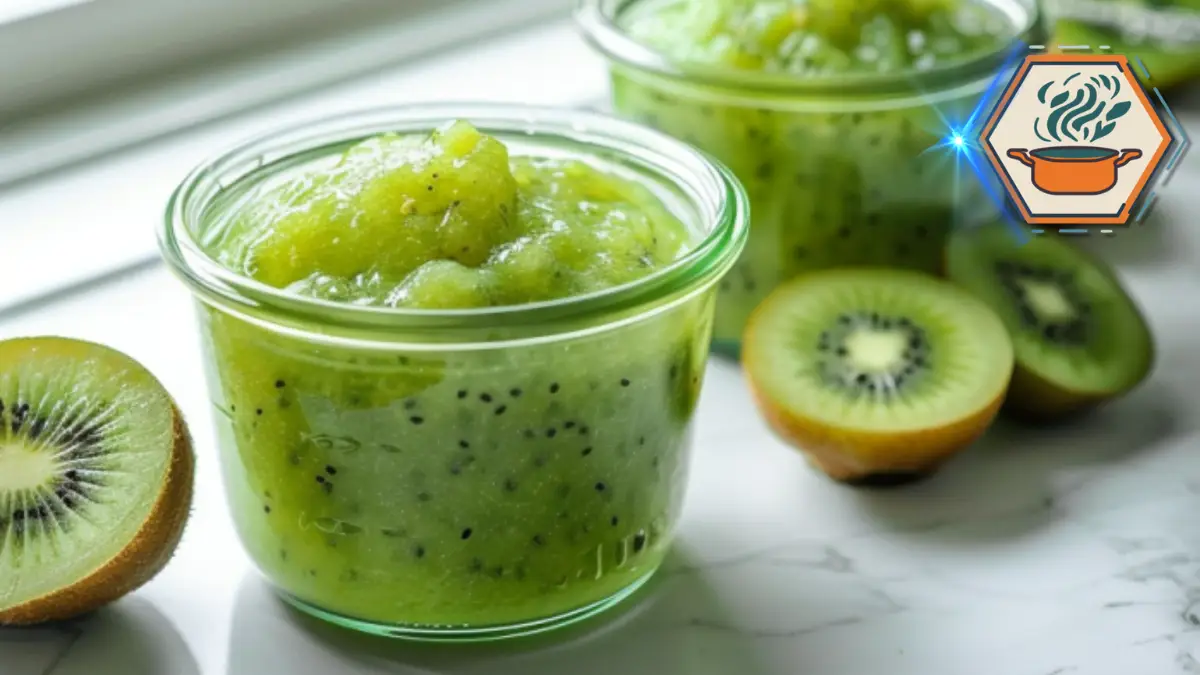Time to read:13 minutes
JUMP TO
From Orchard to Blender: Why Kiwi Puree Works
Kiwi puree opens up easy, bright cooking. Have you ever tried blending ripe kiwis at home? The silky texture and fresh tang surprised me—let me share how you can enjoy it in your daily recipes. This guide covers everything you need: how to pick the best fruit, blend it perfectly, fix common issues, and store your kiwi puree safely. Plus, you’ll discover creative ways to use it in sweet, savory, and baby-friendly recipes—all without overcomplicating things.
From Orchard to Blender: My First Encounter with Kiwi Puree
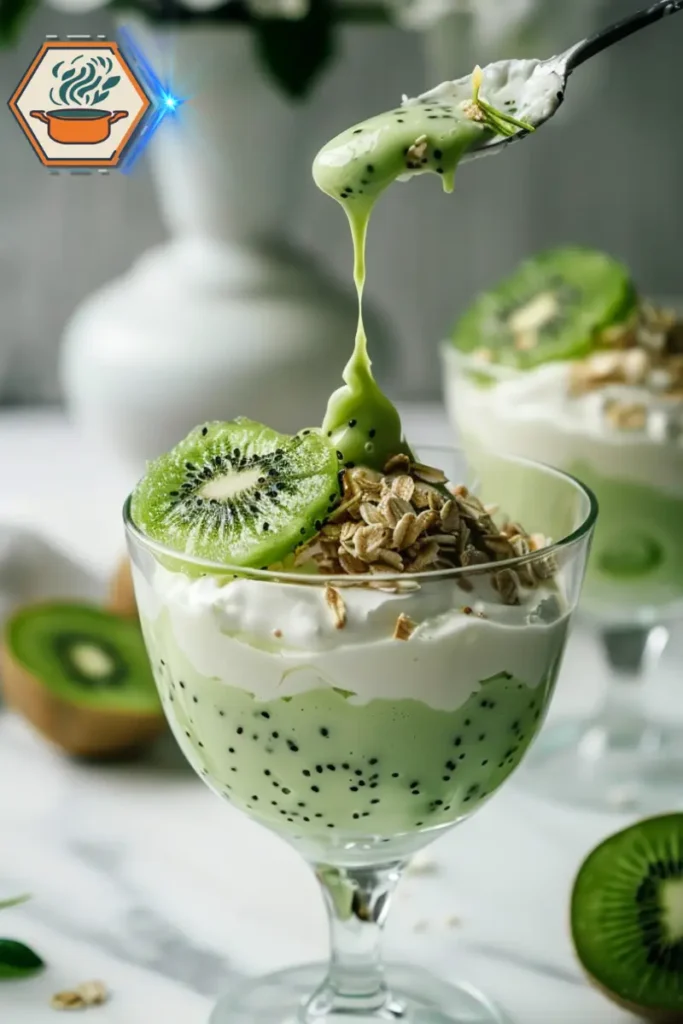
It was a simple morning. I picked a fuzzy fruit, sliced it, and tasted something uniquely tangy. That bite inspired me to recreate it at home. Soon, the blender became my tool of choice. The result was a vibrant green kiwi puree — fresh, light, and naturally sweet.
Since then, it’s found a home in my recipes — whether I’m adding it to a dessert or swirling it into yogurt, the taste is unforgettable. Similar to how you might caramelize crème brûlée without a blowtorch (see how here), it’s about mastering texture and simplicity.
Why Kiwi Puree? Nutrients in Every Spoonful
Kiwi is more than just a fruit. It’s a powerhouse of vitamin C, fiber, and antioxidants. When blended into a kiwi puree, these nutrients remain easy to absorb and gentle on digestion. That’s why it works so well for smoothies, baby food, and recovery diets.
Its natural tartness replaces citrus in many recipes — no need for lemons when kiwi brings brightness. Plus, its hydration content supports digestive health. Curious about how to make a healthy fruit-based pie crust? We even have a guide on using tortillas as crusts (check it here) — try it with kiwi!
Choosing the Right Kiwi for Pureeing
Look for:
- Slight softness to touch
- Brown fuzzy skin with no bruises
- Bright green or golden flesh
- No hard white core inside
Golden kiwis give sweeter results. If your kiwi feels firm, let it ripen at room temperature before blending.
How to Make Kiwi Puree
Follow these steps:
- Wash kiwi under cold water
- Peel (or leave skin if blender handles it)
- Cut into chunks
- Blend with splash of water or juice
- Pulse, then blend until smooth
- Strain if needed for silky texture
This basic method gives a kiwi puree ready for any recipe.
Adjusting Texture for Every Use
- Smoothies: add liquid
- Baby food: ultra smooth, no seeds
- Baking: slightly thick
- Sauces: mix with olive oil, vinegar
Store medium-thick puree in the fridge, and adjust when needed.
Fixing Common Issues in Kiwi Puree
| Problem | Why It Happens | How to Fix |
|---|---|---|
| Too watery | Overripe fruit or added liquid | Chill or stir in chia/pectin |
| Too thick | Less juice or dense fruit | Add a splash of juice or water |
| Bitter seeds | Green kiwis | Use golden kiwis or strain |
| Oxidation | Air exposure | Add lemon juice, use airtight jar |
Great Combinations with Kiwi Puree
Try mixing:
- Banana, mango, or pear
- Coconut milk or yogurt
- Mint or basil
- A touch of honey or lime
For an even sweeter pairing, use it with a banana bread (see this easy recipe).
Print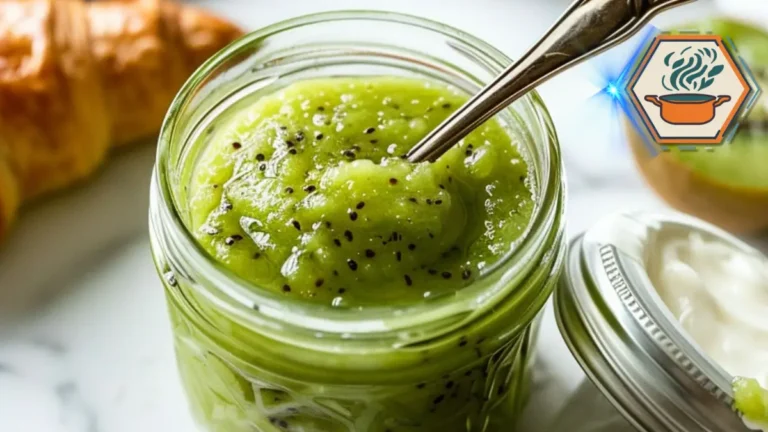
Kiwi Purée (Silky 2-Ingredient Base)
A quick, bright kiwi puree you can blend in minutes. Silky texture, fresh tang, and endless uses—from smoothies and yogurt to sauces and baby-friendly blends.
- Total Time: 10 minutes
- Yield: ~1 cup (240 ml)
Ingredients
4 ripe kiwis (about 500 g), peeled (or scrubbed if your blender handles skin)
1–2 tbsp water or apple juice, as needed
(Optional) 1 tsp lemon juice, to slow browning
Instructions
Wash and peel the kiwis (or keep skin if blending high-speed).
Cut into chunks and add to a blender with 1 tbsp liquid.
Blend until smooth; add more liquid by teaspoons if needed.
For extra-silky texture, pass through a fine mesh strainer.
Taste; add a few drops of lemon if you want a brighter finish.
Notes
For baking, aim for a slightly thicker purée (use less liquid).
For baby portions, strain seeds and start with small servings.
Golden kiwis are sweeter, green varieties are tangier.
- Prep Time: 10 minutes
- Cook Time: 0 minutes
- Category: Condiment / Base
- Method: No-cook (Blended)
- Cuisine: International
- Diet: Gluten Free
Real-Life Uses & Smart Storage with Kiwi Puree
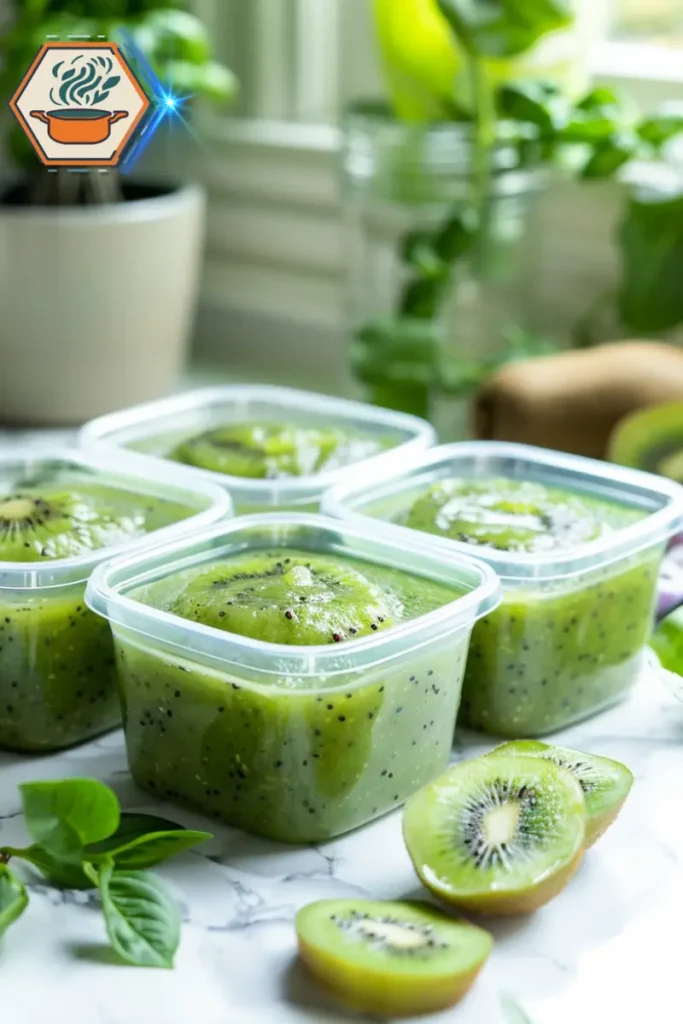
Keeping Kiwi Puree Fresh
- Store in glass containers
- Refrigerate for 2–3 days
- Freeze in ice cube trays
- Label with date
Avoid long exposure to air. Use airtight lids to lock in freshness.
Why Kiwi Puree Turns Brown
Kiwi has enzymes that react with oxygen. To prevent browning:
- Add citrus or lemon juice
- Store quickly after blending
- Keep cold and sealed
This keeps your kiwi puree looking and tasting fresh.
Making Large Batches
When you need more than a single serving:
- Use food processor for big quantities
- Freeze in small containers
- Stir before reuse
Use these tips when preparing for a crowd or meal prep.
Incorporating Kiwi Puree into Meals
Try it:
- In breakfast yogurt bowls
- Mixed into smoothie recipes
- Blended into vinaigrettes
- Swirled into cheesecakes
- On top of pancakes or ice cream
Using kiwi puree in creative ways keeps your meals refreshing.
Nutritional Science Behind Kiwi
According to USDA FoodData Central, kiwi is one of the richest fruits in vitamin C — even more than oranges per gram. It’s also a good source of potassium and fiber. These nutrients remain present in a fresh puree, making it perfect for natural health-boosting recipes.
Use Kiwi Puree with These Recipes
Looking for ideas? Combine it with:
- Milk bar-style pie crusts
- Crispy pancakes
- Vegan chorizo tacos
Or swirl it into your next sweet potato pie (see why it’s nutritious). Its acidity balances sweetness well.
When Texture Needs Tweaking
To make your kiwi puree silky:
- Use high-speed blenders
- Strain using a fine mesh
- Use golden kiwi for fewer seeds
Texture matters, especially in baby food or sauces.
Creative Twists: Flavors, Textures & Pairings
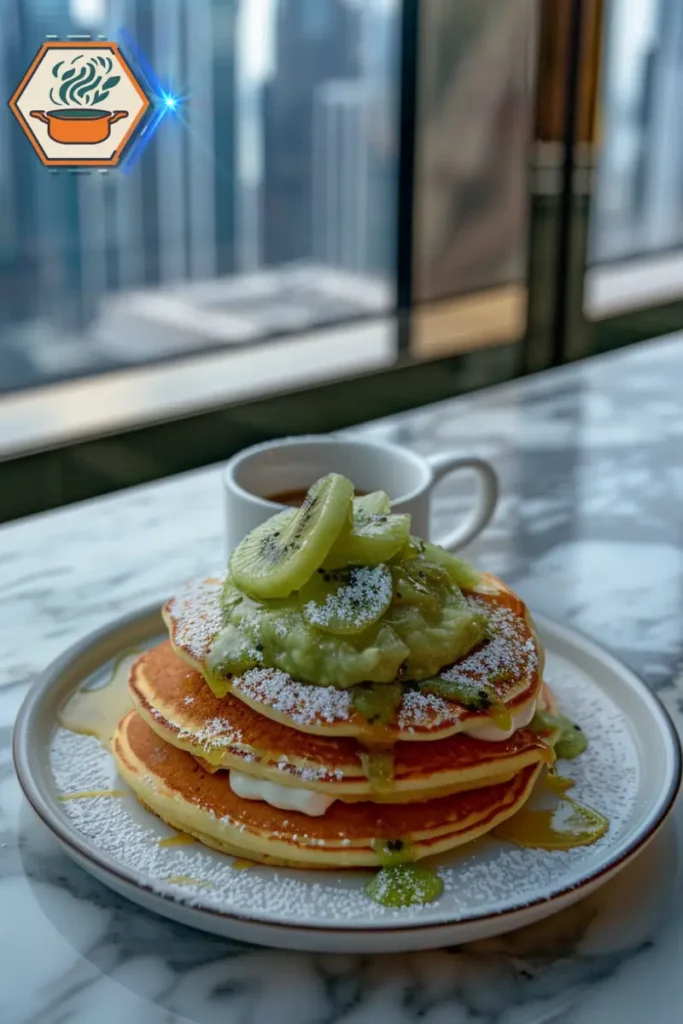
Kiwi puree is a vibrant ingredient that brings tang, color, and nutrition to many dishes. When I first stirred this fruit purée into a smoothie, its emerald shade and tropical tang spoke for itself. In this section, I share practical uses, creative recipes, and smart storage methods to help you make the most of kiwi puree in everyday cooking.
Breakfast & Smoothie Ideas with fruit purée
Starting the day with this purée boosts flavor and nutrition. Here are my favorite ways:
- Green smoothie: blend kiwi puree + banana + spinach + almond milk.
- Over oatmeal or chia pudding: swirl this purée before adding nuts or seeds.
- On pancakes or waffles: spoon fruit purée and top with berries.
- Yogurt mix‑in: stir kiwi purée into plain yogurt or cottage cheese for a tangy twist.
- Over toast: spread ricotta or cream cheese, then add a drizzle of fruit purée.
Because kiwi puree is water‑rich, it blends smoothly. Small chunks of kiwi or skin bits should be strained out for toddler versions.
Baking and Desserts Using fruit purée
You might worry that kiwi puree won’t survive baking. In fact, with care it works beautifully. Use it alone or combined with other fruits. Below are recipe ideas:
- Kiwi mousse or panna cotta: fold cooled this purée into whipped cream or set with gelatin.
- Kiwi sorbet: mix kiwi puree + sweetener + a bit of lemon juice, then churn or freeze.
- Muffins or cupcakes: substitute part of the wet fruit with kiwi purée (for example, half apple sauce, half kiwi puree).
- Tart or cheesecake topping: spread fruit purée over baked base or swirl it lightly.
- Fruit bars or cheesecakes: layer or ribbon kiwi puree through batters.
To avoid sogginess, reduce other liquids slightly. Always taste balance—add a little sweetener or acid if needed.
Savory Dishes and Sauces: Kiwi Puree in Action
One unexpected strength of fruit purée is its role in savory meals. Its mild acidity softens textures and lifts flavors. Try these ideas:
- Salad dressing: whisk fruit purée + olive oil + white wine vinegar + honey + herbs.
- Marinade: combine this purée + garlic + soy sauce or tamari + ginger. Use it on chicken, fish, or pork—the acids help tenderize.
- Drizzle sauce: spoon blended kiwi (thinned with a bit of water or stock) over grilled seafood or pork.
- Dipping sauce: mix kiwi puree + yogurt + cumin or chili flakes.
- Glaze: brush this purée + a bit of glaze sugar over roasted vegetables or meat near end of cooking.
Because fruit purée is somewhat delicate under heat, apply it later in cooking when possible.
Baby Food and Health‑Friendly Uses
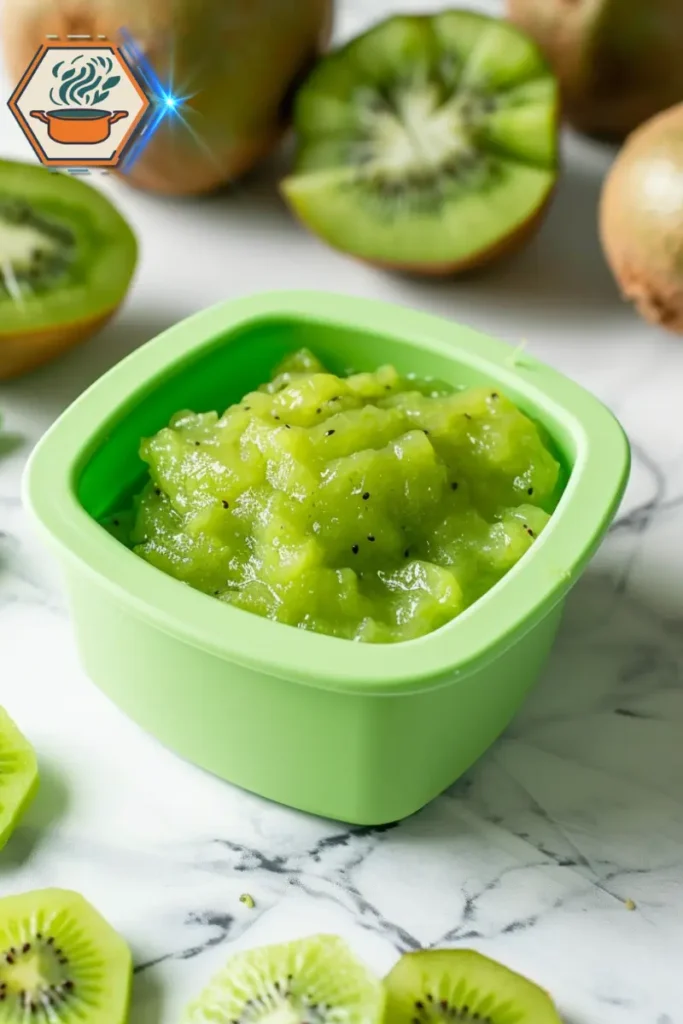
For babies (from about six months, per pediatric guidance) or for people needing soft textures, kiwi puree shines. Here’s how I use it:
- Blend this purée with banana or pear for gentle flavors.
- Strain out persistent seeds to protect sensitive palates.
- Introduce gradually and monitor for allergic reaction.
- Use small portions first; serve alone or mixed with mild vegetables (e.g. sweet potato).
Beyond baby food, kiwi puree works in health‑friendly menus:
- In smoothies for recovery or light meals
- In overnight oats or soft grain bowls
- Paired with probiotic yogurt for digestive support
Storage, Shelf Life, and Freezing Tips
You’ll want to preserve kiwi puree well. From personal testing, these tips work:
| Method | Ideal Container | Duration | Notes |
|---|---|---|---|
| Refrigerator | Airtight jar or container | 3–4 days | Stir before use; discard if off smell |
| Freezing (ice cube tray) | Silicone or plastic tray, then freezer bag | Up to 3 months | Cube size 1–2 tbsp for convenience |
| Freezing (bulk) | Freezer‑safe jar, leave headspace | 2–3 months | Thaw in fridge overnight |
| Partial thawing | In jar with lid but loosened | N/A | Prevents pressure build up |
If thawed kiwi puree seems watery, stir, drain, or gently strain excess liquid. Use faster in hot or humid climates.
Creative Twists: Flavor Combinations & Variations
Over time, I’ve played with flavors to keep this purée fresh and surprising. Some combos include:
- Kiwi + mango or peach: adds natural sweetness
- Kiwi + mint, basil, or cilantro: herbaceous lift
- Kiwi + ginger or turmeric: warming or spicy undertones
- Kiwi + coconut milk or cream: tropical richness
- Kiwi + berry blends: such as strawberry or blueberry
When you blend, start with a base of fruit purée and add small portions of the other fruit or herb. Adjust sweetness and acidity to taste.
The options above make kiwi puree adaptable in both sweet and savory dishes.
Benefits, Recipes & Culinary Innovations with kiwi purée
Kiwi puree adds brightness and nutrition to your meals. From breakfast bowls to savory glazes, it’s versatile and easy to prepare. When I first blended ripe kiwis into a silky green purée, I discovered more than just a fruit sauce—it became a secret ingredient in both sweet and savory cooking.
As a culinary recipe blogger specializing in healthy fruit-based recipes, I’ve tested hundreds of puree techniques on RecipesMind. For example, our creme brûlée and custard post details texture secrets
According to the USDA FoodData Central, kiwi is rich in vitamin C, potassium, and fiber. These nutrients remain mostly intact when you puree the fruit raw, making it ideal for nutrition-focused diets.
Breakfast & Smoothie Recipes Using Kiwi Puree
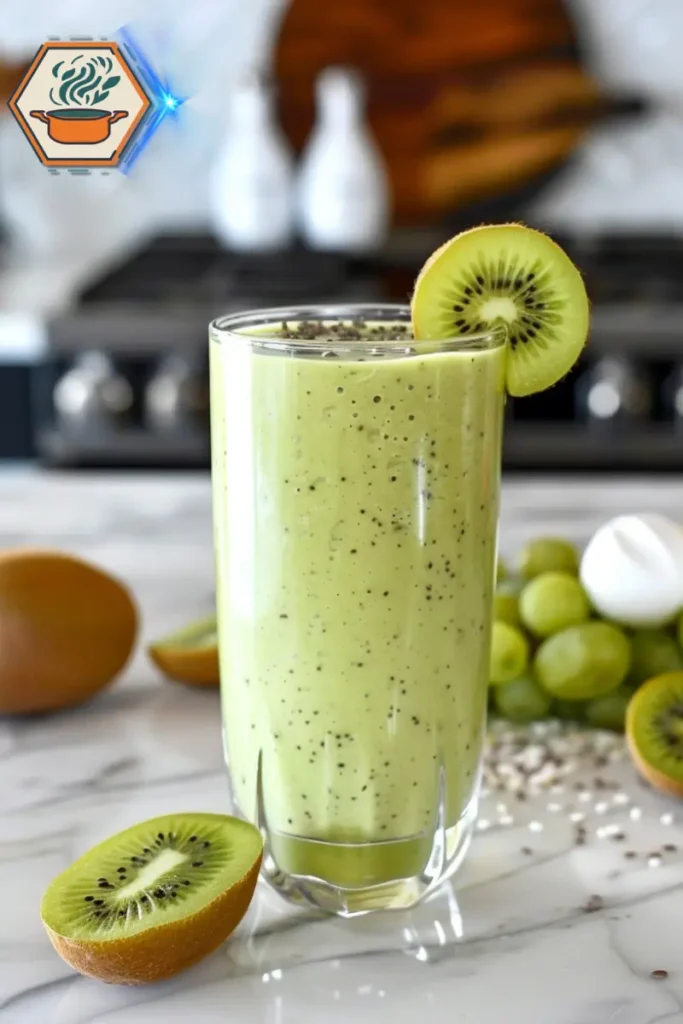
Every morning feels brighter with fruit purée on the menu. Here are ways I include it:
Smoothies
- Kiwi puree + banana + spinach + almond milk = energy-boosting blend
- For protein: add Greek yogurt or hemp seeds
- For immunity: pair with orange or pineapple juice
Oats and Yogurt
- Swirl kiwi puree into oatmeal or overnight oats
- Mix into plain yogurt or cottage cheese for tangy contrast
- Top granola bowls with kiwi puree and toasted coconut
Baking with this purée
Moist Baked Goods
- In muffins or cupcakes, swap applesauce for kiwi puree
- Add to quick breads for tropical flavor
- Use as a swirl in cheesecake or fruit bars
From our baking experiments like the perfect meatloaf recipe, we learned that moisture levels and texture are crucial. The same applies when adding kiwi puree to batters—balance wet ingredients carefully.
Desserts and Frozen Treats
- Make kiwi mousse by folding puree into whipped cream
- Freeze into sorbet or ice pops with sweetener and lime juice
- Layer in trifles or swirl into panna cotta
Use fresh kiwi puree whenever possible for color retention and natural tang.
Savory Ideas, Baby Tips & Storage
The journey of this purée continues beyond the sweet. Its acidity and enzymes make it surprisingly useful in savory meals and health-conscious recipes.
Savory Recipes Using kiwi purée
Marinades & Dressings
- Mix kiwi puree with olive oil, garlic, and vinegar
- Brush over pork or chicken before grilling
- Combine with herbs for a light vinaigrette
The natural enzymes in kiwi help tenderize meats—just like how acidic bases are used in dishes like bone broth marinades.
Exotic Sauces
- Blend kiwi puree with ginger and chili for a dipping sauce
- Add coconut milk and lime for Southeast Asian-style glazes
- Drizzle over roasted vegetables for added brightness
Baby Food & Soft Diet Options
For babies over six months (with seed removal), this purée is gentle and nutrient-rich:
- Combine with banana or pear for a smooth blend
- Strain through mesh for younger babies
- Monitor reactions if it’s a first exposure
It’s also suitable for adults on soft diets or recovery plans.
Table: How to Store Kiwi Puree Effectively
| Storage Method | Container Type | Duration | Notes |
|---|---|---|---|
| Refrigeration | Airtight glass jar | 3–4 days | Keep cold; stir before reuse |
| Freezing (cube trays) | Silicone or BPA-free | Up to 3 mo | Great for portioning smoothies |
| Bulk freezing | Mason jar with space | 2–3 mo | Label with date; thaw in fridge |
If your kiwi puree separates after thawing, stir or gently strain extra liquid. Avoid overfreezing—it can dull the flavor.
Creative Blends & Twists
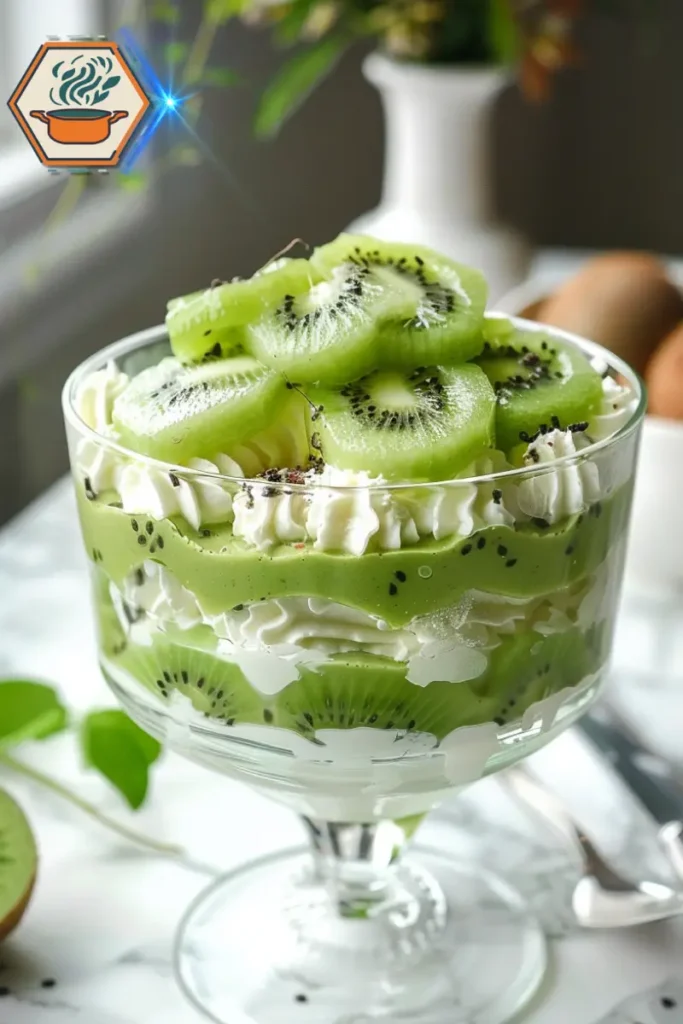
Here are ways I reinvent kiwi puree in the kitchen:
- Kiwi + mango or papaya = tropical smoothie
- Kiwi + mint = cooling sorbet base
- Kiwi + coconut milk = creamy sauce or dessert layer
- Kiwi + berries = vibrant mixed fruit topping
Experimenting with flavor keeps dishes fresh. On RecipesMind, we love playing with combinations like in our tropical baking ideas.
If you’d like more nutritional background, check reliable sources like Harvard’s School of Public Health for information on fruit vitamin content, bioavailability, and how preparation methods affect nutrient retention (see Harvard’s “Vegetables & Fruits” overview).
FAQ
Can kiwi puree be made at home?
Yes! Ripe fruit blends into a smooth kiwi puree in under a minute. It’s ideal for babies, baking, and easy sauces.
Can I give kiwi puree to my 6 month old?
In many regions, yes once solids start. Serve smooth, strained purée in small amounts and watch for reactions. When unsure, consult your pediatrician.
How to prepare kiwi for a baby?
Use ripe fruit, blend very smooth, strain seeds, and serve a spoon or two at first.
What not to mix with kiwi?
Avoid too much extra acid (it can taste sharp). In dairy desserts with gelatin, test a small batch first—kiwi enzymes can affect setting.
Why can’t you eat a lot of kiwi?
Large amounts may feel acidic or cause mouth tingling for some people. Those with latex-fruit sensitivities should be cautious.
Do kiwis blend well?
Very well. They’re water-rich and turn silky fast, especially when ripe.
Is kiwi too acidic for babies?
It can be tangy. Start with small, smooth portions and mix with milder fruits like banana or pear.
Which is better, Apple or kiwi?
Different benefits: apple is mild and pectin-rich; kiwi is higher in vitamin C. Use the one that best fits your recipe and taste.
Is kiwi good for baby brain?
Kiwi provides vitamin C and other nutrients that support overall health. For tailored advice, ask a pediatric professional.

